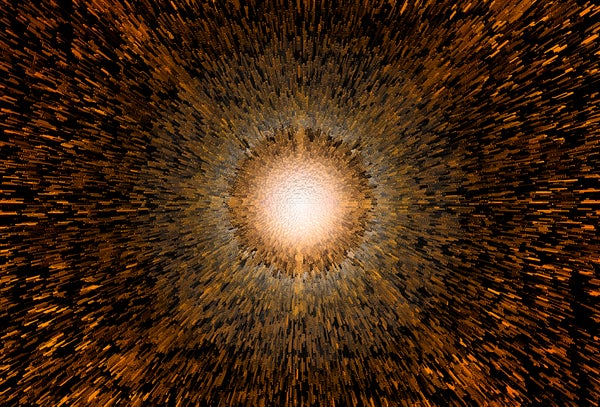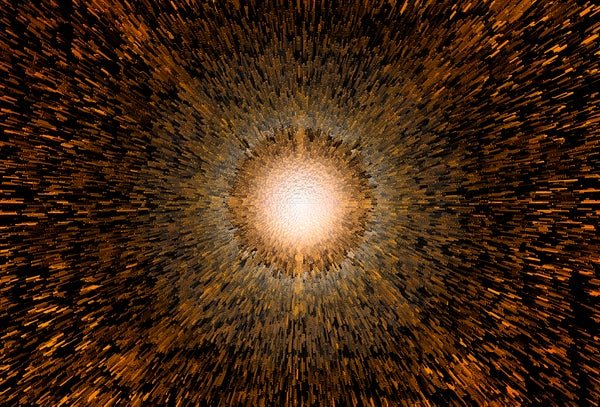October 1, 2024
5 min read
A One-in-10-Billion Particle Decay Hints at Hidden Physics
Physicists have detected a long-sought particle process that may suggest new forces and particles exist in the universe

Imagine Photographer/Getty Images
Once in a very great while, an ephemeral particle called a kaon arises and then quickly decays away into three other obscure entities. Whether or not this happens in a particular way has very little bearing on most of us, who will go about our lives without knowing either way. But to physicists who have been searching for this arcane process for decades, it matters a lot; finding out how often it happens could reveal hidden aspects of our universe.
Now, for the first time, scientists have observed this rare decay, and they have found that it might have slightly higher odds of occurring than its predicted chance of about one in 10 billion. If that turns out to be true, some unseen actor must be interfering in the decay—potentially a new particle or force previously unidentified in nature.
The finding, made at the NA62 experiment at CERN, the European laboratory for particle physics near Geneva, was announced last week. “This is important,” says Andrzej Buras, a theoretical physicist at the Technical University of Munich. Thirty years ago Buras, with his student Gerhard Buchalla, made the first advanced theoretical prediction of how often the decay occurs according to the Standard Model of particle physics. He is “optimistic” it will prove to be more common than expected, but he cautions that the experiment’s findings aren’t yet strong enough to say for sure. “People are excited,” Buras says. “I expect in a few weeks, you will find many new papers [attempting to explain the result], and each one will claim something different.”
On supporting science journalism
If you’re enjoying this article, consider supporting our award-winning journalism by subscribing. By purchasing a subscription you are helping to ensure the future of impactful stories about the discoveries and ideas shaping our world today.
The unlikely process under scrutiny begins with kaons, which are strange—literally. They contain “strange quarks,” weirder and heavier versions of the quarks inside atoms. First discovered in 1947, kaons aren’t commonly found in nature but can be created inside particle detectors, as well as by cosmic rays crashing into Earth’s atmosphere. Kaons decay quickly into lots of various other particles. But the particular decay just observed simply doesn’t happen in the normal course of things.
To catch kaons in the act, the experiment sprays a hose of protons at an unmoving target of beryllium atoms. The collisions produce a lot of kaons, among other things. The kaons then fly down a roughly 150-meter-long vacuum tunnel. Along the journey, they decay. At the end of the tunnel is a detector that aims to measure the identity, velocity and energy of every single particle that passes through it. Only by eliminating everything else can the physicists home in on the rare event they seek: kaons decaying into a pion (a particle made of an “up” quark and an “anti-down” quark), as well as a neutrino and an antineutrino. “The point of the experiment is to see everything with 100 percent efficiency—you can’t miss anything,” says NA62 spokesperson Giuseppe Ruggiero of the University of Florence in Italy and the country’s National Institute for Nuclear Physics.
This decay is so rare because it requires “virtual particles.” The laws of quantum mechanics, odd as they are, allow particles to pop into being out of nothing and quickly disappear again. Sometimes these virtual particles arise as one particle is transforming into another—and change the course of the decay. For instance, when kaons decay, they very occasionally undergo interference from virtual versions of the W and Z bosons (the particles known to carry the weak nuclear force). This meddling is what allows the kaon to produce a pion and two neutrinos, the process NA62 seeks. The Standard Model—the best theory scientists have—predicts this will happen precisely eight times out of every 100 billion decays.
If it happens more or less often, something else must be going on—something beyond what’s described in the Standard Model. “The model works very well, but there are many questions we cannot answer,” Buras says. “The two most important, in my view, are the existence of dark matter and our own existence: Why do we have matter and no antimatter in the universe?”
If measurements of kaon decays don’t match the Standard Model, scientists can conclude that additional virtual particles of unknown variety must be muddying those decays. The new measurement found that the decay happens about 13 times in every 100 billion decays—albeit with an estimated uncertainty of about 25 percent. “It’s promising—it gives us hope that we may discover a deviation from the Standard Model,” says NA62 team member Cristina Lazzeroni, a physicist at the University of Birmingham in England and former spokesperson for the experiment. “But statistically speaking, it’s not a proof. That’s why we need more data.”
If future measurements confirm that the decay contradicts predictions, there are several possible virtual particles that could figure in.
One possibility is a hypothetical particle called a Z′ (pronounced “Z prime”) boson. This would be a much heavier version of the known Z boson. Instead of carrying the weak force, as the regular Z does, the Z′ would carry something else. “It carries a force that probably could shed some light on the open questions [in physics] but has no direct impact on our lives,” Buras says. Another option is a proposed particle, called a leptoquark, that could transform quarks into leptons (the category containing electrons and neutrinos), and vice versa.
Though neither of the potential new particles could directly explain dark matter or other mysteries of our universe, discovering them could pave the way toward answering some of our biggest questions. “It’s like opening a window on a new world,” Lazzeroni says. “Depending on which window you’re opening, the world can be really rich.”
And if these new particles truly exist, they could meddle in other rare particle decays being sought at experiments around the world. In that case, projects such as the Large Hadron Collider beauty (LHCb) experiment at CERN and the Belle II and Japan Proton Accelerator Research Complex (J-PARC) experiments in Japan should also see deviations from the Standard Model in their measurements.
The new result is “very interesting” says André De Gouvea, a theoretical physicist at Northwestern University. “This decay is considered very clean—this means we can compute it with good precision—and is quite sensitive to hypothetical new phenomena.”
The NA62 experiment is due to run for several more years. When it ends, the researchers should have about four times more data than they analyzed for this measurement, which should allow them to increase the precision of their detection significantly. Many physicists will be eagerly awaiting that future analysis, De Gouvea says. “We may be on our way to having a serious puzzle on our hands in a few years,” he adds.








